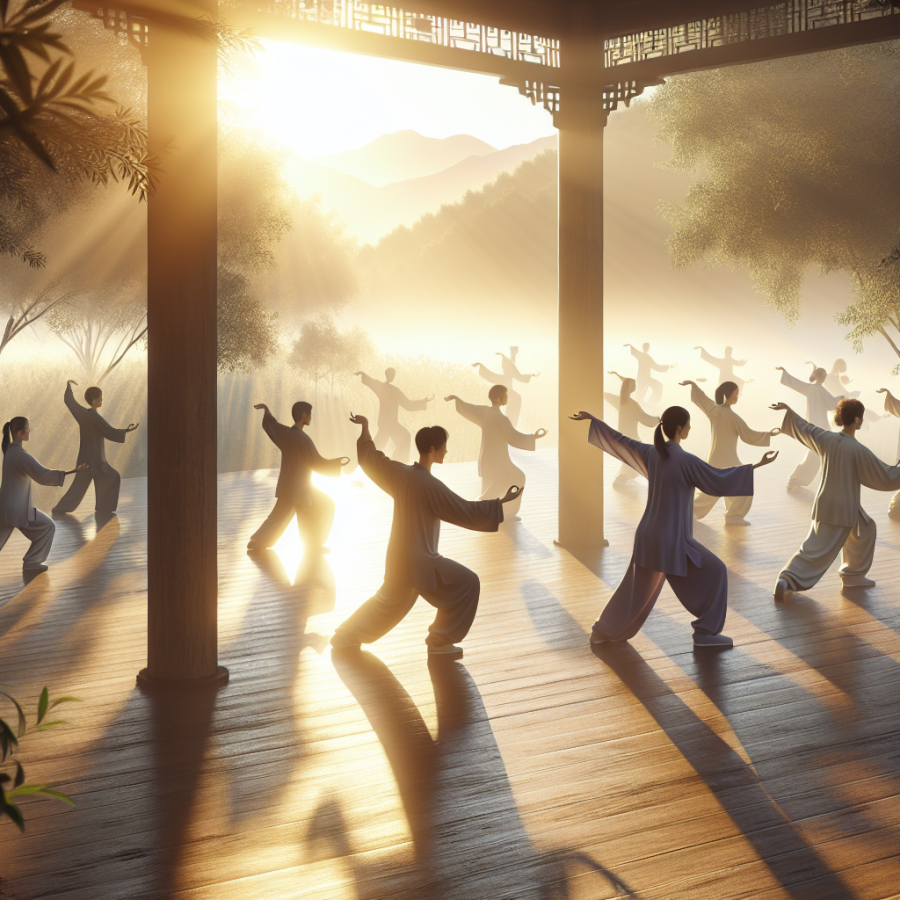Discovering the Calming Power of Tai Chi Movements
Tai Chi, an ancient Chinese martial art known for its gentle and flowing movements, has long been associated with various health benefits. At its core, the practice is based on the principle of Yin and Yang—the balance of opposing forces—and aims to bring harmony to the body and mind. Many who embark on the Tai Chi journey discover its calming power, an effect that can transform their daily lives.
The movements of Tai Chi are performed slowly and deliberately, which allows practitioners to focus on their body’s sensations and the subtleties of their motions. This mindfulness aspect is one of the keys to Tai Chi’s calming effects. By paying close attention to breathing and movement, Tai Chi practitioners find themselves immersed in the present moment, which helps to quiet the mind and reduce stress. This state of mindfulness can have a profound impact on the nervous system, promoting relaxation and decreasing the 'fight or flight' response associated with stress and anxiety.
Not only do the slow, graceful movements of Tai Chi facilitate a sense of peace, but they also encourage deeper breathing. This enhances oxygen flow and can lead to improved circulation, which further supports stress reduction and overall well-being. The deliberate movements encourage the body to let go of tension. As the muscles release their hold, the joints become less rigid, leading to a sense of physical and mental release.
Regular practice of Tai Chi can lead to improved balance and flexibility, which in turn can instill a sense of confidence and strength in practitioners. This is not just about physical strength, but also an inner fortitude that comes from the increased body awareness and control developed through Tai Chi. With each session, the connection between the mind and body is reinforced, building a foundation that can make one feel more grounded and centered in the face of life's challenges.
Tai Chi movements often mirror interactions with the world around us, such as pushing, pulling, and reaching. These movements encourage practitioners to apply the principles of Tai Chi to everyday situations, promoting a calm and balanced approach to any stresses that may arise. By learning to flow with the movements, one also learns to flow with the events of life, confronting them with serenity rather than tension.
As the understanding of Tai Chi deepens, so does the realization of its profound tranquilizing effect. The slow motion routines encourage the cultivation of a quiet, reflective space within the practitioner. This has been likened to moving meditation, where the execution of the movements themselves is a tonic against the chaos of the external world.
Understanding the Origins of Tai Chi: The Ancient Practice of Moving Meditation
At the heart of Tai Chi lies a rich history that stretches back to ancient China, where it was developed as a martial art in the 17th century. Rooted in Taoist and Confucian philosophy, Tai Chi, or Taijiquan, is a practice that encompasses the duality of yin and yang – the passive and active elements of life. The fluid movements of Tai Chi aim to harmonize these opposing forces within the body, promoting a sense of balance and tranquility.
Tai Chi Techniques: The Subtle Art of Controlled Movements
Tai Chi is characterized by its slow, deliberate movements, each flowing seamlessly into the next without pause. These movements, or forms, are designed to cultivate qi – the life energy within us. Through consistent practice, Tai Chi practitioners learn to execute a series of postures with precision and grace, a process that can improve physical coordination, balance, and strength.
The Health Benefits of Regular Tai Chi Practice
Beyond its origins as a martial art, Tai Chi is widely recognized for its health benefits. Research has shown that it can help reduce stress, improve cardiovascular health, and promote better sleep. For older adults, Tai Chi is especially beneficial in enhancing flexibility and reducing the risk of falls. Furthermore, it's a low-impact exercise that can be adapted to suit people of all ages and levels of physical ability.
Tai Chi's Role in Mental and Emotional Well-being
The serenity of Tai Chi extends to mental and emotional health. The meditative aspect of its practice encourages mindfulness and present moment awareness. As a form of moving meditation, it allows individuals to focus inward, reducing anxiety and fostering a peaceful state of mind. Regular practice is known to improve concentration, cultivate self-awareness, and enhance overall emotional resilience.
Incorporating Tai Chi into Daily Life: A Path to Lasting Serenity and Strength
Embracing Tai Chi does not necessarily require large amounts of time or a special venue. Many practitioners find ways to incorporate the principles and movements of Tai Chi into their daily routines. Whether it is through a short morning sequence to start the day, or using Tai Chi breathing techniques to relieve stress during a break at work, the practice is highly adaptable.
Tai Chi and the Community: Group Practice and Cultural Exchange
Tai Chi is often practiced in groups, and this community aspect can enhance the experience.
Unveiling the Physical and Mental Resilience Built Through Tai Chi Practice
Embarking on a Tai Chi journey goes beyond the gentle and fluid movements that are outwardly displayed. This time-honored martial art, deeply rooted in Chinese philosophy, cultivates not only a sense of calm and equilibrium but also a reservoir of resilience on both psychological and physiological fronts. The practice is a tapestry of meditation, breathing, and deliberate movements, fostering a harmonious symbiosis of mind and body that fortifies an individual's ability to withstand, recover, and grow from life's adversities.
Physiologically, Tai Chi's impact on resilience is multifold. Regular practitioners benefit from increased muscular strength and endurance. The low-impact nature of Tai Chi movements helps in enhancing flexibility and balance, which decreases the risk of falls, particularly in the elderly. Meanwhile, the continuous weight shifting stimulates joint health and can result in alleviating symptoms of arthritis. On a cardiovascular level, the practice mirrors moderate exercises that are known to improve heart health, reduce blood pressure, and augment overall stamina.
Tai Chi's contributions to mental resilience are equally compelling. As a meditative practice, it demands present-moment awareness, which sharpens focus and trains the mind to ward off the white noise of daily worries. This mindfulness leads to stress reduction, whereby lowering the levels of the stress hormone cortisol, and provides a buffer against anxiety and depression. The discipline required to master the sequences of Tai Chi also translates into enhanced self-discipline in other aspects of life.
Neurologically, Tai Chi has been associated with better cognitive function. The complexity of its sequences and the need for coordination and spatial awareness serve as cognitive exercises that maintain brain health and can slow cognitive decline. This is especially important in the age of information overload, where the brain's processing capacity is continually challenged.
The social aspect of Tai Chi cannot be understated in discussing resilience. Practicing in groups fosters a sense of community and belonging, which is integral to emotional support and resilience. The exchange of energy and the shared pursuit of mastering the art contributes to a collective strength that empowers each member.
Tai Chi, with its graceful movements and mindfulness, is a powerful ally in building holistic resilience. It exhorts the body to become more robust and supple, conditions the mind to become calmer and more focused, and nurtures the spirit through collective engagement.




